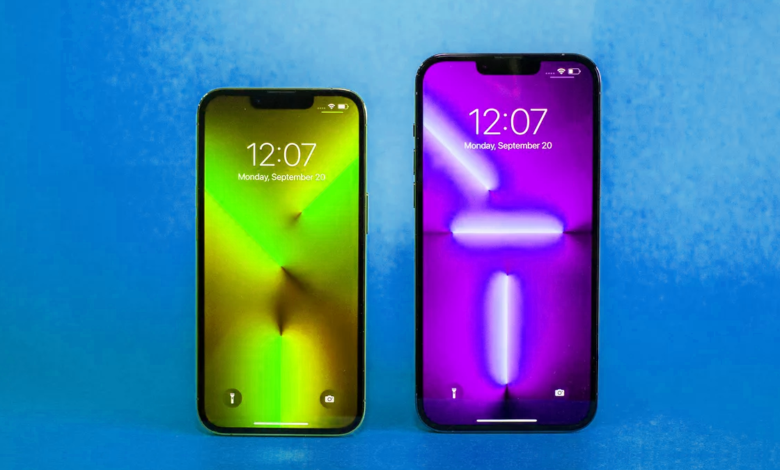iPhone 13 Pro and 13 Pro Max Review: Unique Features

The iPhone 13 Pro and 13 Pro Max boast the greatest cameras and the longest battery life of any iPhone we’ve tested, yet they’re also the most expensive. In order to live up to the Pro designation in their names, both cameras are equipped with a number of high-end features such as the ability to record ProRes footage. Because the iPhone 13 Pro and Max are superb in every way, we’ve awarded them the TechKnowable Editors’ Choice Award for their performance.
For the third year in a row, Apple has announced two Pro models, this time in the form of the iPhone 13 Pro and iPhone 13 Pro Max. This year’s 12 Pro and 12 Pro Max are the same price as last year’s models, but they come with improved cameras, a larger battery, and an A15 Bionic processor. Apple has further clarified the distinction between its Pro and non-Pro phones by incorporating features on the 13 Pro and 13 Pro Max that many of us have sought for years, such as a display with a high refresh rate, in their flagship devices. A three-year-old iPhone Pro looked to be more of a marketing slogan than an indication that the phone was any more professional than an ordinary iPhone, according to some.
The iPhone 13 Pro sends a crucial message: there isn’t a single iPhone that is right for every person. For the first time since last year, both phones feature the identical camera array, with the only differences being in terms of size, battery life, and pricing.
Read More: Google Pixel 5 Review- Google Best Smartphone for upcoming 2021
iPhone 13 Pro and 13 Pro Max
PROS
- Robust build
- ProMotion display
- 3x optical zoom telephoto
- iOS 15
CONS
- It’s heavy
- Lacks on-off setting for macro photography
- The notch
- Cinematic mode is more of a novelty
The iPhone 13 Pro starts at $999 (£949, AU$1,699) and the iPhone 13 Pro Max starts at $1,099 (£1,049, AU$1,849) for 128GB of storage, with the 13 Pro Max starting at $1,099 (£1,049, AU$1,849). For the first time, iPhone users will be able to purchase a device with 1TB of storage. It costs $1,499 ($1,449 ($2,569) for a 13 Pro, and $1,599 ($1,549 ($2,719 ($2,719) for a 13 Pro Max, thanks to the additional storage capacity. The amount of storage space available… and the amount of money available.
The iPhone 13 Pro Gets Beefier
The phones feature the same squared-off appearance that the 12 series phones have. Glamorous stainless steel sides contrast with a matte finish on the back that is available in four colors: graphite, gold, silver, and Sierra blue. In some lighting, the Sierra blue iPhone appears to be light gray, but in other lighting, it appears to be the Carolina blue of the University of North Carolina Tarheels’ uniforms.
The notch has been shrunk by 20 percent. It’s not as wide as it used to be, but there is still a notch. It’s fair to say that it irritates me by a factor of 20 percent less.
Both phones are thicker and heavier than their predecessors. The 13 Pro acquires 15 grams in weight, while the 13 Pro Max adds 12 grams in weight to its already substantial weight. When I was using the 13 Pro, I became more aware of the added weight. In addition to having Apple’s Ceramic Shield on the front of the phones, both are IP68 certified for dust and water resistance.
ProMotion on the iPhone 13 Pro is Stellar
The 13 Pro has a screen that is 6.1 inches in size, while the 13 Pro Max has a screen that is 6.7 inches in size. The screens are substantially brighter when used in normal circumstances. The displays are equipped with ProMotion technology, which means that the iPhone, for the first time ever, can handle a high refresh rate. The refresh rate varies between 10 and 120Hz, depending on what is being displayed on the screen at any one time. This is a similar technique to the one taken by Samsung with the Galaxy S21 Ultra smartphone. When in usage, the screen appears to be flawless. Animations are smoother, images are crisper, and even the most banal activities, such as scrolling feeds, appear to be better.
The iPhone 13 Pro has a Longer Telephoto Camera
The iPhone’s main camera contains a new sensor, which is the largest ever put into a mobile device. It has a lens with a faster f1.5 aperture, which translates to better light gathering capabilities. The ultrawide sports a new auto focus sensor and lens, which improves light gathering while also improving image quality. Last but not least, the telephoto camera has a new sensor and lens that provides a longer 3x optical zoom.
It was true that using the Pro iPhones resulted in brighter photos, but the difference was not always noticeable.
The iPhone 13 Pro Cameras Bring You Even Closer to Your Subject
When you get within a few centimeters of your subject, the new macro mode on the 13 Pro and 13 Pro Max kicks in and captures the shot. I went the iPhone 13 Pro Max and iPhone 13 to the Feast of the Field, which is a part of the annual Euphoria food festival in Greenville, South Carolina, to put the cameras and Macro feature to the test. This resulted in a delectable camera test.
Microphotography is characterized by the fact that, as you go closer to your subject, the camera automatically shifts from its wide angle to its ultrawide angle mode. Now that the ultrawide has autofocus, it can lock focus on objects that are only a few centimeters distant from the camera.
I discovered that macro photography on the iPhone worked well in both bright and moderate conditions. However, while it does not perform to the same level as a mirrorless camera equipped with a dedicated macro lens, it is one of the more effective implementations of a macro mode that I have seen on a phone. The food and coffee I photographed were excellent close-ups. A nightmarish video clip of ants crawling all over a discarded grapefruit was also captured by my camera.
I discovered two things at the main supper for the occasion: first, that the event was a success. Aside from the fact that gooseberries are quite delicious, Furthermore, even in low light, the iPhone still changes to the ultrawide camera in order to snap a macro photo with the telephoto lens. The wide-angle camera on the phone is the most effective, and it also performs admirably in low-light conditions, according to the manufacturer. Furthermore, because the phone must be held so near to the subject, it actually blocks some of the light, resulting in mediocre close-ups. To turn off the macro capability, there isn’t a setting available at this time. The company has stated that a new setting would be implemented in a software update this fall, allowing you to turn off automatic camera switching when shooting at close ranges for macro photography and videography.
Read More: 9 Mistakes to Avoid While Developing E-Commerce Mobile Apps
I’m All About Cinematic Mode on the iPhone 13 Pro
The iPhone 13 is equipped with a new function called Cinematic mode, which is available on all models. It creates a 1080p movie at 30 frames per second using either the rear cameras or the True Depth camera array on the phone. The fact that everything except your subject is out of focus is what makes the video so intriguing. The iPhone may even switch focus from one subject to another using a rack focus feature. The result is both dramatic and amazing, as you can see here.
The depth of field can be adjusted in the same way as it is in Portrait mode for pictures. That the phone can do everything is fantastic, including selecting who is in focus and when to change focus, is a major plus. During the recording process, you have the option to tap and manually modify the focus points and aperture. Alternatively, you can complete all of this after the fact.
Are cinematic videos without flaws? No, but it’s a lot of fun to play with and experiment with. For cinematic mode to function properly, a certain amount of light is required. If the lighting conditions are too dim, you’ll see a pop-up message telling you to turn on your flash.
I also discovered that fast-moving nonhuman subjects, such as water being poured from a faucet or an espresso shot being prepared, were difficult to hold in focus when using Cinematic mode. Furthermore, when editing a film in Cinematic mode, the controls for the focus keyframes are quite small. You can long-press them to make them larger, but as soon as you release your finger from the button, they shrink back to their original size.
Expect Cinematic mode to be your go-to for consistently good-looking videos, but that may not be the case. Although it is a pleasant function, standard video appears to be superior in the vast majority of instances.
Read More: How to control your Mac with your Apple Watch?
Not All A15 Bionic Power is the Same
Apple’s new A15 Bionic processor is at the heart of everything. The GPU of the Pro versions features five cores, as opposed to the 13 and 13 Mini models’ four cores. During my time testing the phones, I found that they were capable of performing a variety of tasks including as gaming, photo editing, and having a number of apps open at the same time.
The iPhone 13 Pro Max has the best battery life of any phone we tested, yet it also the most expensive.
Both the 13 Pro and the 13 Pro Max have a larger battery than the previous models. The fact that it was hot and humid and I had to take a slew of images and films didn’t bother me in the slightest. On a single charge, the iPhone 13 Pro easily lasts a day in my opinion, and the iPhone 13 Pro Max can go up to two days on a single charge. The iPhone 12 Pro and iPhone 12 Pro Max from last year had longer battery lives than this year’s models.
The iPhone 13 Pro lasted 22 hours, 2 minutes while the iPhone 13 Pro Max lasted 31 hours, 19 minutes in TechKnowable’s battery test, which consisted of playing a looping video on Airplane mode with the screen at half brightness while the phone was on standby. The iPhone 13 Pro Max outlasted every other phone TechKnowable has ever tested in terms of battery life.
The fact that the battery is larger is not the sole factor contributing to improved battery performance. The LTPO display, which automatically adjusts the refresh rate, is responsible for a significant portion of the improvement. The iPhone 12 Pro and 12 Pro Max feature a fixed 60Hz refresh rate, however the iPhone 13 Pro and 13 Max have the ability to reduce the refresh rate to as low as 10Hz while consuming significantly less battery.
I’ve just owned all four iPhone 13 models for roughly five days, so there are some features that I need to put through more rigorous testing before I can give you a fair assessment. Let’s wrap things up by talking about a couple of the last questions you may have.
- iOS 15 on the 13 Pro and 13 Pro Max is a fantastic operating system. It offers a slew of new features while remaining largely unchanged from the previous version. Focus mode is one of my favorites.
- Photographic styles, which are available on all iPhone 13 models, are a new feature that allows you to choose between standard, which is the usual iPhone look, and four different styles: Vibrant, Rich Contrast, Warm, and Cool. According to Apple, these are more than simply filters. Using advanced algorithms, your phone evaluates the different features of your subject to add the look you want while avoiding, for example, over-coloring someone’s skin. Apple performs all of this when you are taking the photo, and the results are embedded into the file.
- These will be the first smartphones to utilize Apple’s ProRes video codec, which will be released later this year. Those who color grade or use editing tools such as Final Cut Pro X or Adobe Premiere Pro will find ProRes to be particularly beneficial because it optimizes video files. ProRes video files have a lesser level of compression yet take up a significant amount of space, which is why the 1TB storage tier will be critical. Unfortunately, ProRes is not now ready for testing and will not be accessible till later this year.
iPhone 13 Specs Vs. 13 MINI, 13 PRO, 13 PRO MAX
| iPhone 13 Mini | iPhone 13 | iPhone 13 Pro | iPhone 13 Pro Max | |
|---|---|---|---|---|
| Display size, resolution | 5.4-inch OLED; 2,340×1,080 pixels | 6.1-inch OLED; 2,532×1,170 pixels | 6.1-inch OLED; 2,532×1,170 pixels | 6.7-inch OLED; 2,778×1,284 pixels |
| Dimensions (Inches) | 5.18×2.53×0.3 in | 5.78×2.82×0.3 in | 5.78×2.82×0.3 in | 6.33×3.07×0.3 in |
| Dimensions (Millimeters) | 132x64x7.65 mm | 147x72x7.65 mm | 147x72x7.65 mm | 161x78x7.65 mm |
| Weight (Ounces, Grams) | 4.97 oz; 141g | 6.14 oz; 174g | 7.19 oz; 204g | 8.48 oz; 240g |
| Mobile software | iOS 15 | iOS 15 | iOS 15 | iOS 15 |
| Camera | 12-megapixel (wide), 12-megapixel (ultrawide) | 12-megapixel (wide), 12-megapixel (ultrawide) | 12-megapixel (wide), 12-megapixel (ultrawide), 12-megapixel (telephoto) | 12-megapixel (wide), 12-megapixel (ultrawide), 12-megapixel (telephoto) |
| Front-facing camera | 12-megapixel | 12-megapixel | 12-megapixel | 12-megapixel |
| Video capture | HDR video recording with Dolby Vision up to 4K at 60 fps | HDR video recording with Dolby Vision up to 4K at 60 fps | ProRes video recording up to 4K at 30 fps (1080p at 30 fps for 128GB storage)* | ProRes video recording up to 4K at 30 fps (1080p at 30 fps for 128GB storage)* |
| Processor | Apple A15 Bionic | Apple A15 Bionic | Apple A15 Bionic | Apple A15 Bionic |
| Storage | 128GB, 256GB, 512GB | 128GB, 256GB, 512GB | 128GB, 256GB, 512GB, 1TB | 128GB, 256GB, 512GB, 1TB |
| Expandable storage | No | No | No | No |
| Battery | Undisclosed; Apple lists 17 hours of video playback | Undisclosed; Apple lists 19 hours of video playback | Undisclosed; Apple lists 22 hours of video playback | Undisclosed; Apple lists 28 hours of video playback |
| Fingerprint sensor | No (Face ID) | No (Face ID) | No (Face ID) | No (Face ID) |
| Connector | Lightning | Lightning | Lightning | Lightning |
| Headphone jack | No | No | No | No |
| Special features | 5G enabled; MagSafe; water resistant (IP68); wireless charging; dual-SIM capabilities (nano-SIM and e-SIM) | 5G enabled; MagSafe; water resistant (IP68); wireless charging; dual-SIM capabilities (nano-SIM and e-SIM) | ProMotion technology with adaptive refresh rates up to 120Hz; lidar scanner; 5G enabled; MagSafe; water resistant (IP68); wireless charging; dual-SIM capabilities (nano-SIM and e-SIM) | ProMotion technology with adaptive refresh rates up to 120Hz; lidar scanner; 5G enabled; MagSafe; water resistant (IP68); wireless charging; dual-SIM capabilities (nano-SIM and e-SIM) |
| Price off-contract (USD) | $699 (128GB), $799 (256GB), $999 (512GB) | $799 (128GB), $899 (256GB), $1,099 (512GB) | $999 (128GB), $1,099 (256GB), $1,299 (512GB), $1,499 (1TB) | $1,099 (128GB), $1,199 (256GB), $1,399 (512GB), $1,599 (1TB) |
| Price (GBP) | £679 (128GB), £779 (256GB), £979 (512GB) | £779 (128GB), £879 (256GB), £1,079 (512GB) | £949 (128GB), £1,049 (256GB), £1,249 (512GB), £1,449 (1TB) | £1,049 (128GB), £1,149 (256GB), £1,349 (512GB), £1,549 (1TB) |
| Price (AUD) | AU$1,199 (128GB), AU$1,369 (256GB), AU$1,719 (512GB) | AU$1,349 (128GB), AU$1,519 (256GB), AU$1,869 (512GB) | AU$1,699 (128GB), AU$1,869 (256GB), AU$2,219 (512GB), AU$2,569 (1TB) | AU$1,849 (128GB), AU$2,019 (256GB), AU$2,369 (512GB), AU$2,719 (1TB) |












2 Comments